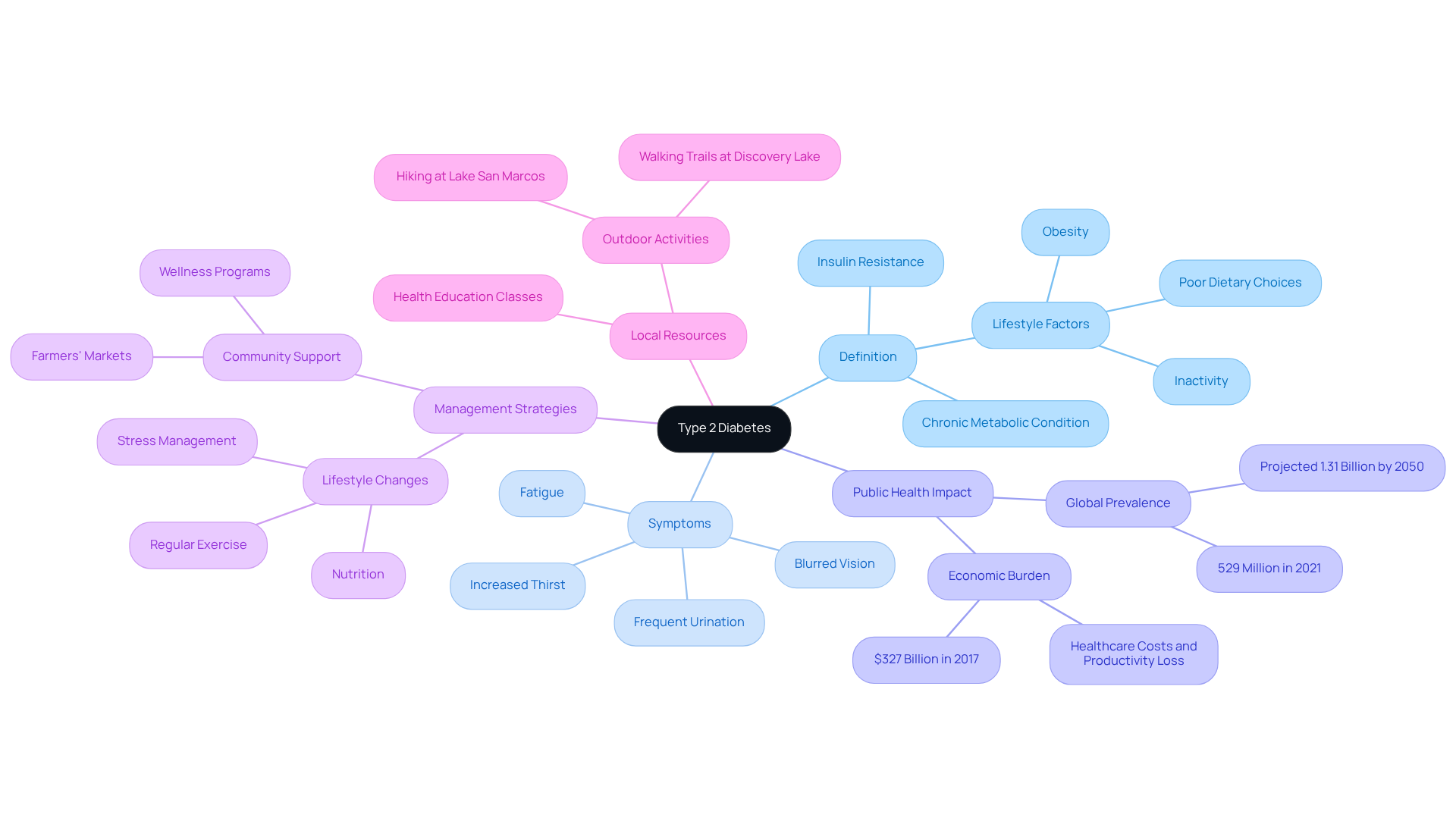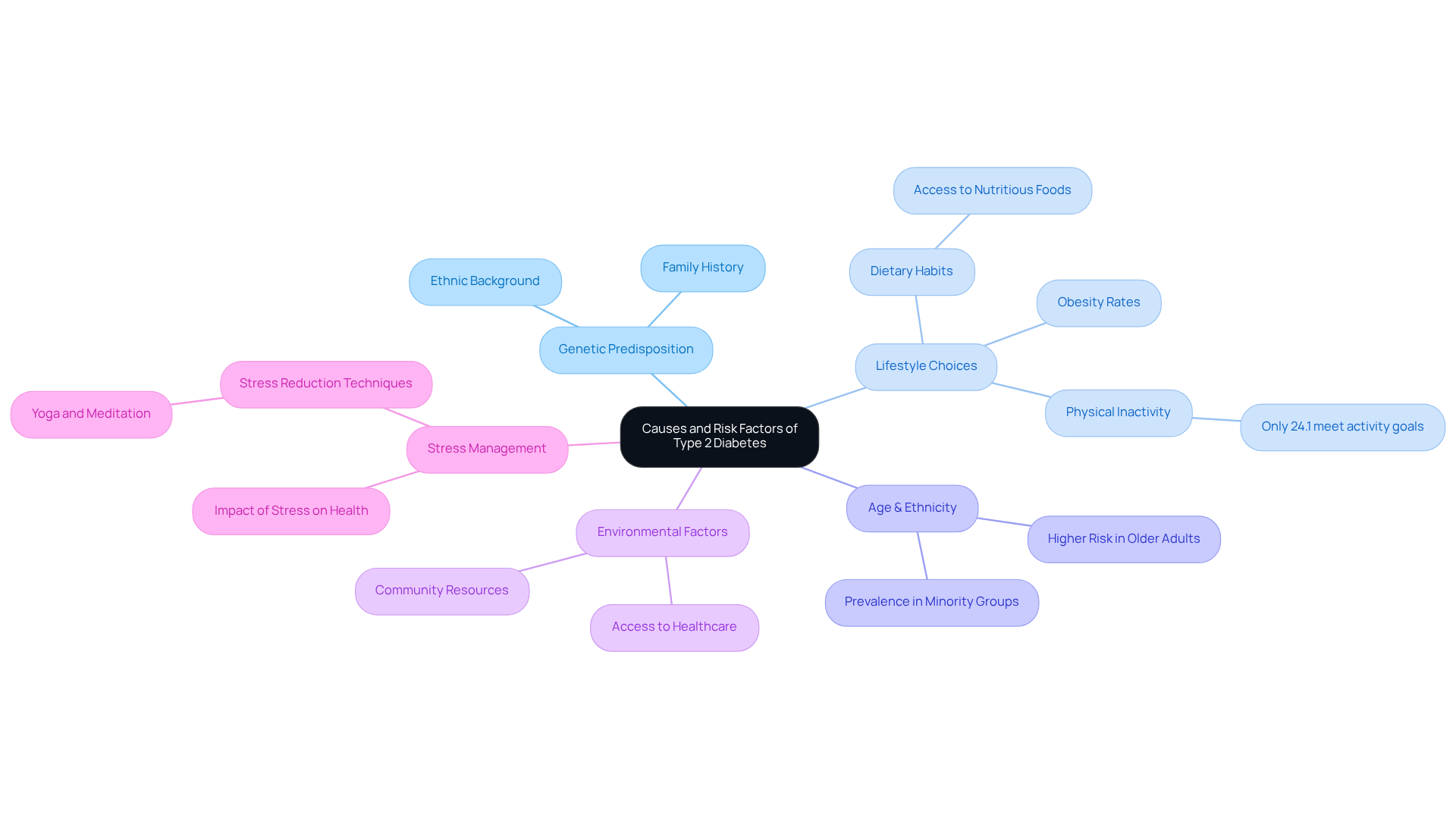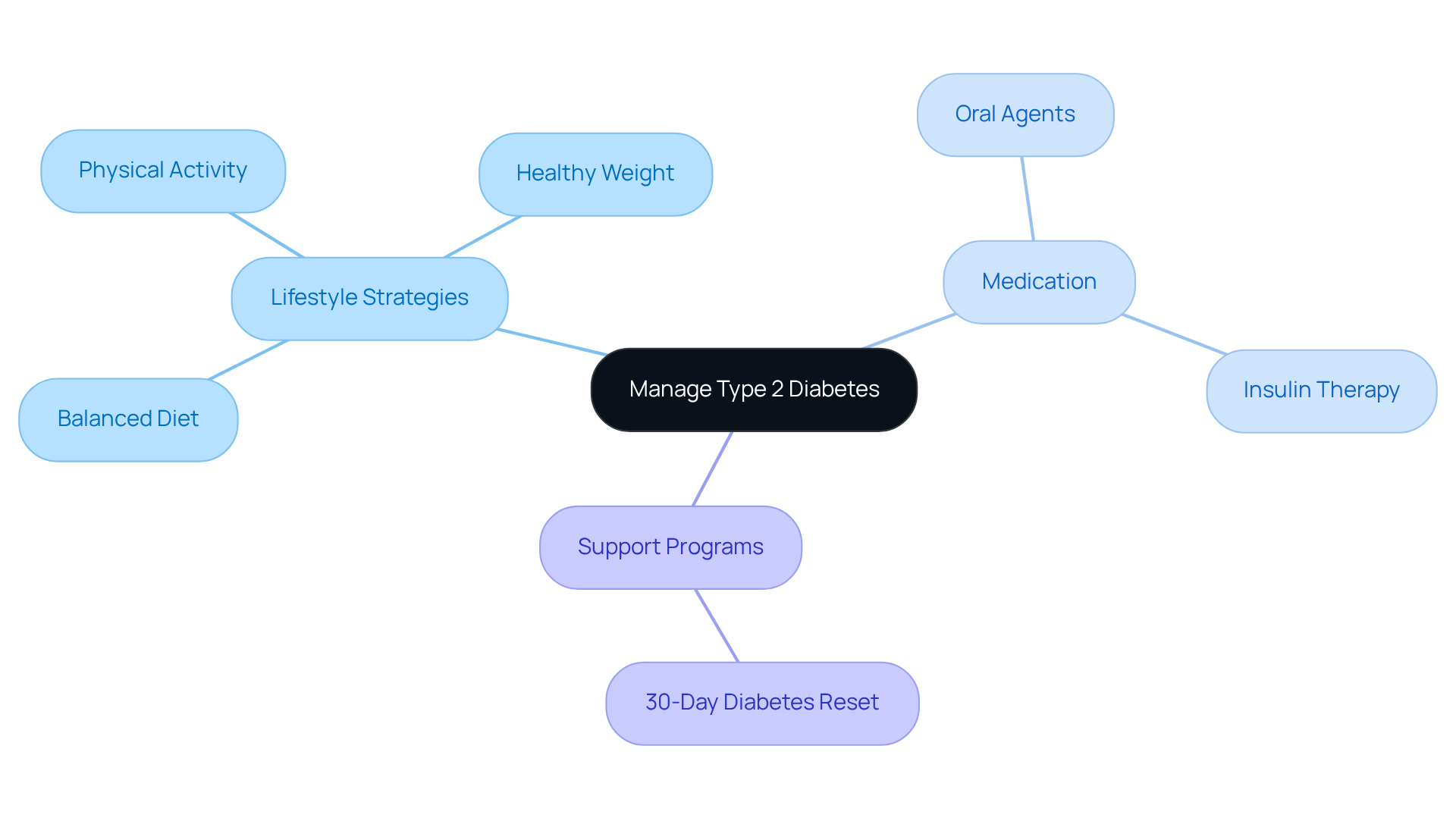Overview
Type 2 diabetes is a chronic metabolic condition that many people face, characterized by persistent high blood sugar levels. This often results from insulin resistance or insufficient insulin production. It’s important to recognize that lifestyle factors, such as obesity and inactivity, play a significant role in this condition. Understanding Type 2 diabetes is essential for effective management, and many patients find that making lifestyle changes can lead to better health outcomes.
Have you ever felt overwhelmed by the challenges of managing your diabetes? You’re not alone. The journey can be tough, but there’s hope. Community resources and personalized support are crucial in preventing complications and improving overall well-being. By embracing these changes, you can take control of your health and live a fulfilling life.
Remember, small steps can lead to significant improvements. Consider exploring the 30-Day Diabetes Reset program, which offers guidance tailored to your needs. It’s never too late to prioritize your health and make positive changes. Together, we can navigate this journey toward better health.
Introduction
In an era where chronic health conditions are on the rise, understanding Type 2 diabetes has never been more critical. This metabolic disorder affects over half a billion people worldwide, and it’s not just a personal health issue; it represents a growing public health crisis linked to lifestyle choices like diet and physical activity. Many individuals find themselves overwhelmed by the implications of this diagnosis. As the prevalence of this condition continues to escalate, it’s important to recognize that there are proactive measures individuals can take to manage their health and mitigate risks.
Exploring the intricate relationship between lifestyle factors, community resources, and effective management strategies can reveal a pathway to better health. Many patients discover that small changes can lead to significant improvements in their quality of life. By fostering a supportive environment and seeking guidance, those navigating the challenges of Type 2 diabetes can find hope and empowerment on their journey toward healthier living. Are you ready to take the first step toward a healthier future?
Define Type 2 Diabetes: Understanding the Condition
The diabetes type 2 definition refers to a chronic metabolic condition that many individuals face, characterized by persistent hyperglycemia. This occurs when the body becomes resistant to insulin or doesn’t produce enough insulin to manage glucose levels effectively. It’s important to recognize that, unlike Type 1 diabetes, which is primarily an autoimmune disorder, the diabetes type 2 definition often highlights its connection to lifestyle factors such as obesity, inactivity, and poor dietary choices. Common symptoms include increased thirst, frequent urination, fatigue, and blurred vision, which can be quite distressing for those affected.
This condition is a significant public health concern, impacting over 529 million people globally in 2021. Projections suggest that this number could rise to approximately 1.31 billion by 2050. Many patients find that the diabetes type 2 definition is crucial to understand, as proper management can prevent serious health complications, including cardiovascular disease and kidney failure. Recent studies highlight the complex factors contributing to the diabetes type 2 definition, emphasizing the need for personal habit adjustments and proactive healthcare approaches to combat this growing epidemic.
In San Marcos, CA, managing Type 2 diabetes can be approached holistically. Lifestyle changes that emphasize nutrition, regular exercise, community support, and stress management are essential. Engaging with local resources, such as farmers’ markets for fresh produce and community wellness programs that offer health education and nutrition classes, can provide vital support. Outdoor activities—like hiking at Lake San Marcos or walking the trails at Discovery Lake—can not only enhance physical fitness but also improve blood sugar control.
Dr. Jason Shumard, D.C., is dedicated to helping patients reverse their condition by providing a clear diabetes type 2 definition along with personalized guidance and tailored nutrition strategies. By focusing on these holistic approaches, individuals can effectively manage their blood sugar levels and improve their overall well-being. Remember, you are not alone in this journey, and with the right support and resources, you can take meaningful steps toward a healthier life.
Explore Causes and Risk Factors of Type 2 Diabetes
The diabetes type 2 definition highlights that the causes are multifaceted, stemming from a blend of genetic predisposition and lifestyle choices. It’s important to recognize that being overweight or obese significantly raises the chances of developing the condition described by the diabetes type 2 definition. In fact, approximately 89.8% of U.S. adults with type 2 diabetes are classified as overweight or obese, highlighting the strong correlation between obesity rates and the prevalence of this illness. Many patients find that a passive lifestyle further increases this risk; only 24.1% of adults with high blood sugar achieve the recommended target of at least 150 minutes of recreational physical activity each week.
In San Marcos, CA, individuals can tackle these challenges by adopting an active outdoor lifestyle, utilizing the area’s parks and trails for regular exercise. Engaging in activities like hiking at Lake San Marcos or walking the trails at Discovery Lake not only helps improve insulin sensitivity but also enhances overall well-being. Incorporating outdoor activities into your routine can be a fun and effective way to stay active.
Age and ethnicity also play significant roles in the likelihood of developing the condition described in the diabetes type 2 definition. For instance, the prevalence of diagnosed diabetes is notably higher among certain racial and ethnic groups, with American Indian and Alaska Native adults exhibiting the highest rates at 13.6%. Furthermore, individuals aged 65 and above encounter a higher likelihood, with over one in four in this age category identified with the condition. A family history of diabetes type 2 definition is another important factor; offspring of parents with the illness have a significantly heightened chance of developing it themselves.
Environmental factors, including access to nutritious foods and opportunities for physical activity, are vital in determining lifestyle choices that affect the risk of diabetes-related conditions. San Marcos offers vibrant farmers’ markets where residents can find fresh, local produce, such as avocados and berries, which are essential for a diabetes-friendly diet. Incorporating seasonal fruits and vegetables into meals can help regulate blood sugar levels and support overall health.
Moreover, managing stress is crucial for regulating blood sugar levels. Engaging in activities like yoga or meditation, often available through local studios or community centers, can help reduce stress and improve mental well-being. The World Health Organization (WHO) predicts that global fatalities from diabetes will double by 2030, underscoring the urgent need for preventive measures and early diagnosis.
Understanding these risk factors empowers individuals to take proactive steps in preventing the condition described in the diabetes type 2 definition. By making informed choices about their lifestyle—such as maintaining a healthy weight, engaging in regular physical activity, and utilizing community resources for support—individuals can significantly reduce their risk of developing this chronic condition. For personalized guidance and support tailored to your unique needs, consider reaching out to Dr. Jason Shumard in San Marcos, CA.
Manage Type 2 Diabetes: Treatment and Lifestyle Strategies
Managing type 2 diabetes can be a challenging journey, but you are not alone. It requires a comprehensive approach that combines changes in habits, medication, and consistent monitoring of blood glucose levels. Essential strategies for living well include:
- Adopting a balanced diet rich in whole foods
- Engaging in regular physical activity
- Achieving a healthy weight
Have you considered that the American Diabetes Association recommends at least 150 minutes of moderate-intensity exercise each week to enhance your overall health and glucose control?
While lifestyle changes are foundational, many patients find that they may also need medication, such as oral agents or insulin therapy, to effectively manage their blood sugar levels. It’s important to recognize that education and support play a vital role in this process, empowering you to make informed health decisions. Programs like Dr. Jason Shumard’s 30-Day Diabetes Reset offer valuable resources and community support. They help participants navigate the complexities of diabetes management, fostering a sense of empowerment in your health journey. Remember, every step you take towards better health is a step worth celebrating.
Conclusion
Understanding Type 2 diabetes is essential in addressing the growing public health crisis associated with this chronic metabolic condition. It’s important to recognize that this disease is not just a personal health issue but a significant concern that affects millions worldwide. By acknowledging the multifaceted nature of Type 2 diabetes—rooted in lifestyle choices, genetic predisposition, and environmental factors—individuals can take proactive steps toward effective management and prevention.
Many patients find that making lifestyle changes can be transformative. Adopting a balanced diet, engaging in regular physical activity, and utilizing community resources for support are crucial steps. The article emphasizes that individuals can significantly reduce their risk of developing Type 2 diabetes by making informed choices and seeking guidance from health professionals. Programs like Dr. Jason Shumard’s 30-Day Diabetes Reset showcase the value of education and community support in navigating the complexities of diabetes management.
Ultimately, the journey toward managing Type 2 diabetes requires commitment and a holistic approach. By embracing healthier habits, leveraging local resources, and fostering a supportive environment, individuals can empower themselves to take control of their health. As the prevalence of this condition continues to rise, it is crucial to prioritize prevention and management strategies now more than ever. Taking that first step can lead to a healthier future, underscoring the significance of understanding and addressing Type 2 diabetes today.
Frequently Asked Questions
What is Type 2 Diabetes?
Type 2 Diabetes is a chronic metabolic condition characterized by persistent hyperglycemia, which occurs when the body becomes resistant to insulin or does not produce enough insulin to manage glucose levels effectively.
How does Type 2 Diabetes differ from Type 1 Diabetes?
Unlike Type 1 Diabetes, which is primarily an autoimmune disorder, Type 2 Diabetes is often connected to lifestyle factors such as obesity, inactivity, and poor dietary choices.
What are common symptoms of Type 2 Diabetes?
Common symptoms include increased thirst, frequent urination, fatigue, and blurred vision.
How prevalent is Type 2 Diabetes globally?
As of 2021, Type 2 Diabetes impacted over 529 million people worldwide, with projections suggesting this number could rise to approximately 1.31 billion by 2050.
Why is it important to understand the definition of Type 2 Diabetes?
Understanding the definition is crucial for proper management, which can prevent serious health complications, including cardiovascular disease and kidney failure.
What lifestyle changes can help manage Type 2 Diabetes?
Essential lifestyle changes include improving nutrition, engaging in regular exercise, seeking community support, and managing stress.
What local resources are available for managing Type 2 Diabetes in San Marcos, CA?
In San Marcos, resources include farmers’ markets for fresh produce, community wellness programs that offer health education and nutrition classes, as well as outdoor activities like hiking and walking trails to enhance physical fitness.
Who can help with managing Type 2 Diabetes?
Dr. Jason Shumard, D.C., provides personalized guidance and tailored nutrition strategies to help patients reverse their condition and manage their blood sugar levels effectively.


